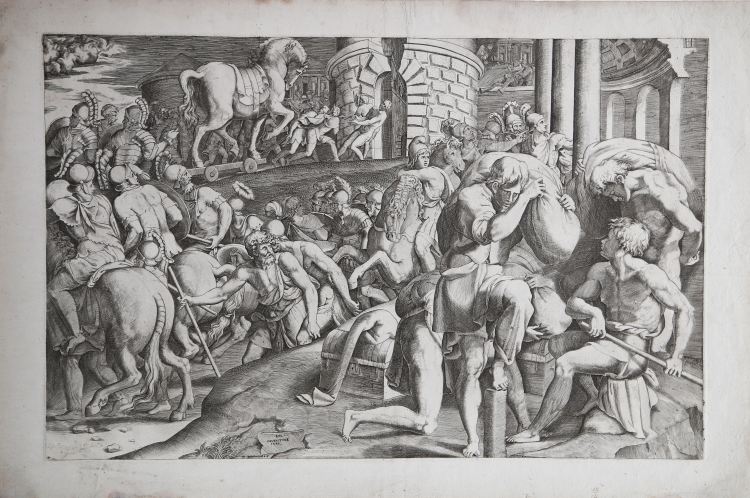



| Reference: | S41926 |
| Author | Giulio BONASONE |
| Year: | 1545 |
| Measures: | 633 x 412 mm |


| Reference: | S41926 |
| Author | Giulio BONASONE |
| Year: | 1545 |
| Measures: | 633 x 412 mm |
Engraving, signed, dated and inscribed on a tablet lower centre: 'BOL/INVENTORE/1545/IV BONASONIS F'. After Primaticcio.
The engraving was executed using two plates. It represents the scene from Trojan War recounted by Virgil (Aeneid, 2, 99 ff). The Trojan, thinking that after ten years the Greeks have lifted their siege and departed, find outside gate a wooden horse left as an offering to the Trojans’ gods. The horse is shown being brought into the city gate. That night the Greek soldiers hidden inside the horse open the gates to their compatriots, and Troy falls.
According to Massari, the print derives directly from a damaged drawing in reverse, today in Windsor, Royal Library, inv. no. 5139, attributed to Francesco Primaticcio by Popham and Wilde. Bruce Davis supposed that Giulio Bonasone might have met Primaticcio in Rome when he came to acquire antiquities for Francis I. Cirillo Archer in TIB suggests that both drawing and print record a lost painting by Primaticcio, once perhaps in the Galerie d'Ulysse at Fontainebleau. According to Davis, the print might reflect an initial idea for the series from the life of Ulysses, which he eventually initiated with The Sack of Troy.
The second state was published by Pietro de Nobili, the third by Carlo Losi.
The present example, probably in the third final state, shows signs of abrasion in the area that held the editorial address.
Very good example, printed on contemporary laid and watermarked paper, wide margins, in perfect condition.
|
Cirillo Archer in TIB 1995, 2803.085.S1; Bartsch XV.134.85; Massari 1983, no. 43.
|
Giulio BONASONE (Bologna circa 1500 - Roma circa 1580)
|
Giulio Bonasone was born in Bologna in 1510; he was engraver, etcher and, as a painter, he was a pupil of Lorenzo Sabbatici.
The critics have ascribed to him 400 prints; nearly all of them are kept nowadays in the Institute of Graphic Design in Rome, widening the list of Bartsch, who had identified just 354 subjects. Bonasone started working in 1531 as copperplate engraver, as it can be seen from his S. Cecilia, and he was considered a follower of Marcantonio’s style in the last years. But Bonasone showed his own style quite soon, for Parmigianino asked him to engrave many of his works.
He lived in Rome between 1544 and 1547, working for the most important publishers of the time (Salamanca, Barlacchi, Lafrery), engraving subjects from Michelangelo, Raphael, Giulio Romano, Perin del Vaga and Polidoro da Caravaggio with his peculiar style.
|
|
Cirillo Archer in TIB 1995, 2803.085.S1; Bartsch XV.134.85; Massari 1983, no. 43.
|
Giulio BONASONE (Bologna circa 1500 - Roma circa 1580)
|
Giulio Bonasone was born in Bologna in 1510; he was engraver, etcher and, as a painter, he was a pupil of Lorenzo Sabbatici.
The critics have ascribed to him 400 prints; nearly all of them are kept nowadays in the Institute of Graphic Design in Rome, widening the list of Bartsch, who had identified just 354 subjects. Bonasone started working in 1531 as copperplate engraver, as it can be seen from his S. Cecilia, and he was considered a follower of Marcantonio’s style in the last years. But Bonasone showed his own style quite soon, for Parmigianino asked him to engrave many of his works.
He lived in Rome between 1544 and 1547, working for the most important publishers of the time (Salamanca, Barlacchi, Lafrery), engraving subjects from Michelangelo, Raphael, Giulio Romano, Perin del Vaga and Polidoro da Caravaggio with his peculiar style.
|